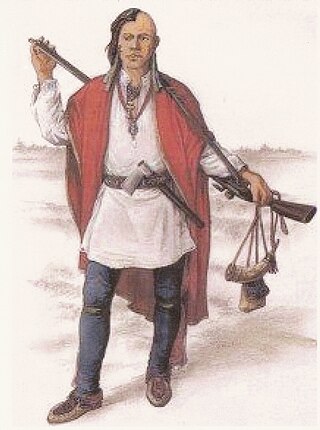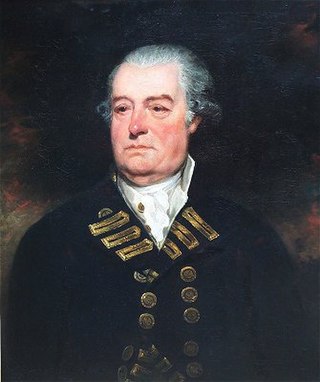Related Research Articles

Machias Seal Island is an island in disputed water between the Gulf of Maine and the Bay of Fundy, about 16 km (10 mi) southeast from Cutler, Maine, and 19 km (12 mi) southwest of Grand Manan Island, New Brunswick. Sovereignty of the island is disputed by the United States and Canada. The Canadian Coast Guard continues to staff a lighthouse on the island; the first lighthouse was constructed there in 1832.

Captain Jeremiah O'Brien (1744–1818) was an Irish-American captain in the Massachusetts State Navy. Prior to its existence, he commanded the sloop Unity when he captured the British armed schooner HMS Margaretta in the Battle of Machias, the first naval battle of the American Revolutionary War. He also led the first American attack on Nova Scotia in the Raid on St. John (1775). Six United States ships were named in his honor.

The Battle of Fort Cumberland was an attempt by a small number of militia commanded by Jonathan Eddy to bring the American Revolutionary War to Nova Scotia in late 1776. With minimal logistical support from Massachusetts and four to five hundred volunteer militia and Natives, Eddy attempted to besiege and storm Fort Cumberland in central Nova Scotia in November 1776.

The Treaty of Watertown, the first foreign treaty concluded by the United States of America after the adoption of the Declaration of Independence, was signed on July 19, 1776, in the Edmund Fowle House in the town of Watertown, Massachusetts Bay. The treaty established a military alliance between the United States and the St. John's and some of the Mi'kmaw bands against Great Britain for the early years of the American Revolutionary War. Seven Mi'kmaw bands chose to decline the American treaty.

The 84th Regiment of Foot (Royal Highland Emigrants) was a British regiment in the American Revolutionary War that was raised to defend present day Ontario, Quebec and Atlantic Canada from the constant land and sea attacks by American Revolutionaries. The 84th Regiment was also involved in offensive action in the Thirteen Colonies; including North Carolina, South Carolina, Georgia, Virginia and what is now Maine, as well as raids upon Lake Champlain and the Mohawk Valley. The regiment consisted of 2,000 men in twenty companies. The 84th Regiment was raised from Scottish soldiers who had served in the Seven Years' War and stayed in North America. As a result, the 84th Regiment had one of the oldest and most experienced officer corps of any regiment in North America. The Scottish Highland regiments were a key element of the British Army in the American Revolution. The 84th Regiment was clothed, armed and accoutred the same as the Black Watch, with Lieutenant Colonel Allan Maclean commanding the first battalion and Major General John Small of Strathardle commanding the second. The two Battalions operated independently of each other and saw little action together.
Colonel John Allan M.P. J.P. was a Canadian politician who became an officer with the Massachusetts Militia in the American Revolutionary War. He served under George Washington during the Revolutionary War as Superintendent of the Eastern Indians and Colonel of Infantry, and he recruited Indian tribes of Eastern Maine to stand with the Americans during the war and participated in border negotiations between Maine, and New Brunswick.
Frederic Kidder was an American author and antiquarian. He was born in New Ipswich, New Hampshire, was mainly self-educated, and engaged in various business ventures in Boston and New York. He made special researches into the history of early New England times and families. He wrote:

The history of Nova Scotia covers a period from thousands of years ago to the present day. Prior to European colonization, the lands encompassing present-day Nova Scotia were inhabited by the Mi'kmaq people. During the first 150 years of European settlement, the region was claimed by France and a colony formed, primarily made up of Catholic Acadians and Mi'kmaq. This time period involved six wars in which the Mi'kmaq along with the French and some Acadians resisted the British invasion of the region: the French and Indian Wars, Father Rale's War and Father Le Loutre's War. During Father Le Loutre's War, the capital was moved from Annapolis Royal, Nova Scotia, to the newly established Halifax, Nova Scotia (1749). The warfare ended with the Burying the Hatchet ceremony (1761). After the colonial wars, New England Planters and Foreign Protestants immigrated to Nova Scotia. After the American Revolution, Loyalists immigrated to the colony. During the nineteenth century, Nova Scotia became self-governing in 1848 and joined the Canadian Confederation in 1867.

Jonathan Eddy was a British-American soldier, who fought for the British in the French and Indian War and for the Americans in the American Revolution. After the French and Indian War, he settled in Nova Scotia as a New England Planter, becoming a member of the General Assembly of Nova Scotia. During the American Revolutionary War, he was strongly supportive of the rebellion against the Crown. He encouraged the residents of Nova Scotia to join in open revolt against King George III and England. He led a failed attempt to capture Fort Cumberland in 1776 and was forced to retreat to Massachusetts, the place of his birth. The following year, he led the defense of Machias, Maine during the Battle of Machias (1777). After the war, he established the community now known as Eddington, Maine in 1784, where he died.

The Battle of Machias was an early naval engagement of the American Revolutionary War, also known as the Battle of the Margaretta, fought around the port of Machias, Maine.

Joseph Gorham was an American colonial military officer during King George's War and later a British army commander during the Seven Years' War and the American Revolutionary War. He is best known for leading a company of British imperial Rangers, called Gorham's Rangers, during the 1750s and early 1760s. Gorham's unit played an important role in the French and Indian War and were early practitioners of American frontier warfare, more commonly known as petite guerre or Guerrilla warfare. He also became Governor of Placentia.

The Battle of Machias was an amphibious assault on the Massachusetts town of Machias by British forces during the American Revolutionary War. Local militia aided by Indian allies successfully prevented British troops from landing. The raid, led by Commodore Sir George Collier, was executed in an attempt to head off a planned second assault on Fort Cumberland, which had been besieged in November 1776. The British forces landed below Machias, seized a ship, and raided a storehouse.

The St. John River expedition was an attempt by a small number of militia commanded by John Allan to bring the American Revolutionary War to Nova Scotia in late 1777. With minimal logistical support from Massachusetts and approximately 100 volunteer militia and Natives, Allan's forces occupied the small settlement at the mouth of the Saint John River in June 1777.

Nova Scotia is a Canadian province located in Canada's Maritimes. The region was initially occupied by Mi'kmaq. The colonial history of Nova Scotia includes the present-day Maritime Provinces and the northern part of Maine, all of which were at one time part of Nova Scotia. In 1763, Cape Breton Island and St. John's Island became part of Nova Scotia. In 1769, St. John's Island became a separate colony. Nova Scotia included present-day New Brunswick until that province was established in 1784. During the first 150 years of European settlement, the colony was primarily made up of Catholic Acadians, Maliseet, and Mi'kmaq. During the last 75 years of this time period, there were six colonial wars that took place in Nova Scotia. After agreeing to several peace treaties, the long period of warfare ended with the Halifax Treaties (1761) and two years later, when the British defeated the French in North America (1763). During those wars, the Acadians, Mi'kmaq and Maliseet from the region fought to protect the border of Acadia from New England. They fought the war on two fronts: the southern border of Acadia, which New France defined as the Kennebec River in southern Maine, and in Nova Scotia, which involved preventing New Englanders from taking the capital of Acadia, Port Royal and establishing themselves at Canso.

New Ireland was a Crown colony of the Kingdom of Great Britain twice established in modern-day Maine after British forces captured the area during the American Revolutionary War and again during the War of 1812. The colony lasted four years during the Revolution, and eight months during the War of 1812. At the end of each war the British ceded the land to the United States under the terms of the Treaty of Paris and the Treaty of Ghent, respectively.
Machias is a town in and the county seat of Washington County in Down East Maine, United States. As of the 2020 census, the town population was 2,060. It is home to the University of Maine at Machias and Machias Valley Airport, a small public airport owned by the town. The word Machias roughly translates in Passamaquoddy as "bad little falls", a reference to the Machias River. Machias is best known as the site of the first naval battle of the American Revolution.

The Battle off Liverpool took place on 24 April 1778 during the American Revolutionary War. The raid involved the British vessel HMS Blonde and the French 24-gun frigate Duc de Choiseul.

The Raid on Saint John took place on 27 August 1775 during the American Revolutionary War. The raid involved American privateers from Machias, Massachusetts Bay attacking Saint John, Nova Scotia. The privateers intended to stop the export of supplies being sent to the loyalists in Boston. This raid was the first hostile act committed against Nova Scotia and it resulted in raising the militia across the colony.

The Province of Nova Scotia was heavily involved in the American Revolutionary War (1776–1783). At that time, Nova Scotia also included present-day New Brunswick until that colony was created in 1784. The Revolution had a significant impact on shaping Nova Scotia, "almost the 14th American Colony". At the beginning, there was ambivalence in Nova Scotia over whether the colony should join the Americans in the war against Britain. Largely as a result of American privateer raids on Nova Scotia villages, as the war continued, the population of Nova Scotia solidified their support for the British. Nova Scotians were also influenced to remain loyal to Britain by the presence of British military units, judicial prosecution by the Nova Scotia Governors and the efforts of Reverend Henry Alline.
A truckhouse or truck-house was a type of trading post established by legislation in the colonies of British America to regulate the North American fur trade. Truckhouses were maintained in the early to mid-18th century.
References
- ↑ Letter from Stephen Smith, Machias June 22, 1776. In Kidder, Frederic. Military operations in eastern Maine and Nova Scotia during the revolution. 1898.
- ↑ Sprag's Journal of Maine's history, 1921. Vol. 9, No. 1, pp. 30–31
- ↑ Kidder, Frederic. Military operations in eastern Maine and Nova Scotia during the revolution. 1898., p. 127
- ↑ Frederic, p. 203
- ↑ p. 223